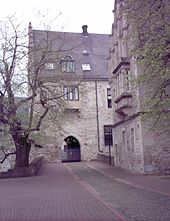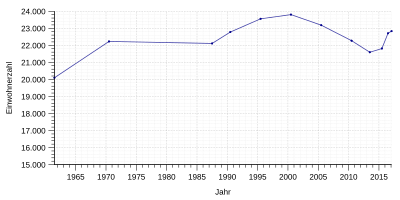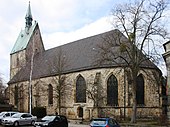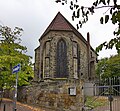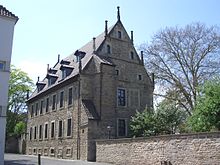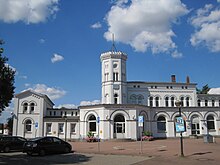Stadthagen
| coat of arms | Germany map | |
|---|---|---|

|
Coordinates: 52 ° 19 ′ N , 9 ° 12 ′ E |
|
| Basic data | ||
| State : | Lower Saxony | |
| County : | Schaumburg | |
| Height : | 72 m above sea level NHN | |
| Area : | 60.27 km 2 | |
| Residents: | 22,262 (Dec. 31, 2019) | |
| Population density : | 369 inhabitants per km 2 | |
| Postal code : | 31655 | |
| Area code : | 05721 | |
| License plate : | SHG, RI | |
| Community key : | 03 2 57 035 | |
| LOCODE : | DE STH | |
City administration address : |
Rathauspassage 1 31655 Stadthagen |
|
| Website : | ||
| Mayor : | Oliver Theiss (independent) | |
| Location of the city of Stadthagen in the Schaumburg district | ||
Stadthagen is the district town of the Schaumburg district (former Schaumburg-Lippe district and Grafschaft Schaumburg ) in Lower Saxony , about 40 km west of Hanover . In its history it was a residence and for a short time a university town.
geography
The city is located between Minden and Hanover in the center of the Schaumburg district on federal highway 65 . In the south the Bückeberg rises , a foothills of the Weserbergland, in the northwest lies the Schaumburg Forest .
Neighboring municipalities in clockwise order are the municipalities of Lauenhagen , Lüdersfeld , Heuerßen , Beckedorf , Apelern and Auetal , the city of Obernkirchen and the municipalities of Nienstädt , Helpsen , Hespe , Meerbeck , Nordsehl and Niedernwöhren .
Stadthagen is divided into the following districts:
- Stadthagen with Brandenburg and the Bruchhof
- Enzen
- Hobbensen
- Habichhorst-Blyinghausen
- Hörkamp-Langenbruch with parts of the Brandshof (Forsthaus Halt)
- Cancer Hagen
- Obernwöhren with Habrihausen
- Probsthagen with the Schäferhof
- Reinsen with Remeringhausen
- Wendthagen-Ehlen with the Wendthöhe
history
Count Adolf III. von Holstein-Schaumburg founded a settlement called indago comitis (Hagen des Graf) around 1222 . The name civitas et castrum (town and castle), which is documented in 1244, indicates its future importance . In 1287 the city changed its name to Grevenalveshagen (Count Adolfs Hagen), and in 1378 the name Stadthagen finally prevailed.
In 1344 it was granted city rights. The stone fortifications were built around 1400, of which the tower at the cattle market, a smaller tower at the castle and some of the city walls were built. In 1501, coal mining began in Stadthagen, which continued until 1961. In 1559, Count Otto IV, residing in Stadthagen , introduced the Lutheran creed together with his second wife Elisabeth Ursula von Braunschweig-Lüneburg , a daughter of Ernst the Confessor , and summoned Jakob Dammann to Stadthagen. His predecessor Count Adolf XI. Between 1534 and 1538, the Tübingen master builder Jörg Unkair built the present-day castle on the site of an older castle complex. The official gate was built in 1553 at what was then the Oberntor.
In 1607, Count Ernst zu Schaumburg moved the residence from Stadthagen to Bückeburg . Two years later, the count's mausoleum was built at the back of St. Martini's Church. In 1610 Stadthagen received a high school illustrious , which was elevated to university in 1620, but was moved to Rinteln in 1621 .
The Obernstrasse and Niedernstrasse received the first sewer system in 1825. The construction of the Minden Hanover railway line began in 1847, and today's station building was built at the same time. The first street lighting, directional lanterns , was installed in 1864, followed by gas lighting in 1899 and electric lighting in 1955. At the end of the 19th century, work began on converting the ramparts into a tree-lined park. The Wendthöhe glass factory existed from 1855 to 1923 . In 1917 the company PA Rentrop (today Faurecia ) came to Stadthagen. The Free State of Schaumburg-Lippe was founded after the end of the monarchy in 1918.
In many German cities on 9 November 1938, the synagogues of the Jewish community by the Nazis on fire were put in Stadthagen this happened in the night of 11 to 12 November 1938. The then Mayor Fritz Hamel Berg claimed after the Second World War , he I did not want an attack on the Stadthagen synagogue on November 9, 1938 . Therefore, the synagogue was only set on fire two days later when he was out of town. It is unclear whether Hamelberg's refusal or other reasons were actually decisive for this fact. The Reichspogromnacht was preceded by the ousting of Jewish citizens from public and social life. The Jewish department store Elias Lion was Aryanized in 1938 after numerous boycotts and taken over by the merchant Thomas. During the Second World War , the city was spared from targeted bomb attacks. The city was hit by aerial bombs only three times during that time. The castle, the Hanover - Minden railway line, as well as the area of today's Windmühlenstraße were the places where the bombs fell. On April 9, 1945, Stadthagen was captured by American troops without resistance, which saved the city from war damage.
In 1948 Stadthagen became the district town of the newly founded district of Schaumburg-Lippe and in 1977 of the new district of Schaumburg. Due to the municipal reform with the incorporation of the surrounding municipalities in 1974, the population of Stadthagen increased to 23,000. In 1982 the city administration was rebuilt on the site of the old city brewery. In the years 1980 to 1990 parts of the inner city streets and the market square were converted into a pedestrian zone.
Mining in Stadthagen
In 1501 coal mining began in Stadthagen.
With the construction and sinking of the Georgschachtes near Stadthagen, which was inaugurated in 1902 by Prince Georg zu Schaumburg-Lippe, the heyday of mining there began. The system, which was operated with the most modern technology at the time, comprised the winding tower, the machine house with the steam hoisting machine, the coal washing machine, the power station, the colliery house with offices and laundry facilities, as well as the water tower and various workshops. In 1925 a second shaft was sunk to a depth of 353 m underground. About 2,600 miners found work on the Georgschacht, as well as 64 civil servants and employees.
Hopes for an expansion of the mining area to Beckedorf , Auhagen , Düdinghausen and Blyinghausen in the 1950s were not fulfilled, and so Preussag decided in 1960 to shut down the pits because mining was no longer economical. Since then, the Georgschacht has been an industrial ruin. The coal bunker of the former coking plant was demolished in 2007 because it was in disrepair.
Incorporations
On March 1, 1974, the communities of Enzen, Habichhorst-Blyinghausen, Hobbensen, Hörkamp-Langenbruch, Krebshagen, Obernwöhren, Probsthagen, Reinsen, Reinsen-Remeringhausen and Wendthagen-Ehlen as well as parts of the communities of Nordsehl (Brandenburg) and Nienstädt (Bruchhof) were incorporated.
Population development
The Bertelsmann Stiftung's demography report counts the district town as “demographic type 8” (strongly aging municipalities). Stadthagen is also forecasting a population decline of 8.1% between 2012 and 2030. So far, the development has not been confirmed, as the population has been rising continuously for several years. However, this growth could only be achieved through increased immigration, in particular by foreigners, since the death rate per 1000 inhabitants at 14.5 is far above the birth rate of 8.1 children per 1000 inhabitants.
The average age of the Stadthäger population was 49.5 years in 2016, well above the national average of 43.9 years. The youth quotient (under 20-year-olds per 100 people of working age) was 31.4%, while the old-age quotient (over 65-year-olds per 100 people of working age) was 63%.
The district town traditionally has a high proportion of foreigners. As early as the 1970s, many guest workers settled in Stadthagen. A total of 3734 of the around 22,800 citizens of Stadthäger had a foreign passport or dual nationality in 2017. This corresponds to a share of 24.2%. In the core city, especially in the western part of the city, the proportion of foreigners is much higher than in the districts. Around 28% of all foreign citizens of Stadthagen live here. Overall, the proportion of foreigners in this quarter was 48.3% in 2017.
| year | Residents |
|---|---|
| 1961 | 20.097 |
| 1970 | 22,228 |
| 1987 | 22,109 |
| 1990 | 22,778 |
| 1995 | 23,556 |
| 2000 | 23,802 |
| 2005 | 23,181 |
| 2010 | 22,272 |
| 2013 | 21,594 |
| 2014 | 21,694 |
| 2015 | 21,814 |
| 2016 | 22,148 |
| 2017 | 22,158 |
religion
Evangelical Lutheran parishes are the St. Martinigemeinde Stadthagen , the parish Wendthagen and the parish Probsthagen.
There is also the Kreuzgemeinde Stadthagen, which is part of the Independent Evangelical Lutheran Church (SELK), and the Evangelical Reformed Church Community in the monastery church .
The free churches in Stadthagen include the Bethel chapel congregation ( Baptists ) and the Ev. Ecclesia Free Church and the Seventh-day Adventist Church.
The Catholic community can be found in the St. Joseph Church.
Other Christian congregations are the New Apostolic Church, the Church of Jesus Christ of Latter-day Saints. In addition to Christian houses of worship, there are also three mosques in total in Stadthagen.
In 2011, 50.7% of the citizens of Stadthäger belonged to the Protestant Church and 9.6% to the Catholic Church. The remaining 39.7% were non-denominational or had a different belief.
politics
City council
The city council of Stadthagen consists of 34 councilors. The directly elected full-time mayor is an additional member. The following table shows the distribution of seats in the city council after the 2016 local elections; the figures for the 2006 and 2011 elections are also given for comparison.
| SPD | CDU | WE 1 | Green | FDP | left | BfS 2 | total | voter turnout | |
| 2016 | 13 | 11 | 4th | 3 | 2 | 1 | - | 34 seats | 50.7% |
| 2011 | 15th | 11 | 2 | 4th | 1 | 1 | - | 34 seats | 44.1% |
| 2006 | 15th | 13 | 1 | 2 | 2 | - | 1 | 34 seats | 49% |
1 voter initiatives in the Schaumburg region; 2 citizens for Stadthagen
The following groups were formed:
- SPD / The Greens / FDP (18 seats)
- CDU (11 seats)
- WE (4 seats)
- Die Linke (1 seat without parliamentary group status)
mayor
Mayor is the non-party Oliver Theiss. In the 2014 local elections, with a turnout of 52.82%, he received 39.95% of the votes, the CDU candidate Heiko Tadge 25.66% of the votes and the SPD candidate Bernd Hellmann 34.38%. So there was a runoff election on June 15, 2014, in which Theiss won with 61.92% of the vote. In the runoff election, the turnout was 46.35%.
coat of arms
The coat of arms of the city of Stadthagen consists of a silver shield in which there is a red wall gate with three towers. In the open gate hovers a red shield with silver nettle-like shield fittings. Above the city arms is a three-towered gray (stone-colored) wall crown . The small closed gate in the wall gate is light brown, the three tower knobs up to the roof are gilded, while all windows are black. All the masonry and the tower roofs are black grouted.
The oldest town seal, from which the town coat of arms emerges, dates from 1324. The nettle leaf is the coat of arms emblem of the Schaumburg counts. It has its origins in the Schaumburg on the Nesselberg in the Wesertal, the ancestral seat of the noble family .
Town twinning
Sister cities are
-
 Tapolca , a small Hungarian town with around 20,000 inhabitants north of Lake Balaton , and
Tapolca , a small Hungarian town with around 20,000 inhabitants north of Lake Balaton , and -
 Eisenberg in Thuringia
Eisenberg in Thuringia
Culture and sights
Museums
- Local history museum in the official gate
- Multimedia staging of the Renaissance experience in the Martini Church and the mausoleum on the subject of the Reformation
music
Stadthagen is home to nationally known bands and orchestras, including the school orchestra of the Ratsgymnasium Stadthagen ("Ratsband") as well as numerous church trombone choirs. In addition, the St. Martini Church maintains a brass band based on the English model, the “St. Martini Brass Band Stadthagen ”. The marching band of the volunteer fire brigade is also known .
In addition to the orchestras, there are also numerous choirs in Stadthagen. These include the “Stadthagen Choir Community”, the nationally known choir “Kreuz & Quer” and the Enzen-Hobbensen men's choir.
Buildings

- St. Martini Church , built in 1318
- Mausoleum of the Counts and Princes of Schaumburg-Lippe , begun in 1608 by the Electoral Saxon court architect Giovanni Maria Nosseni and completed by the architect and court painter Anton Boten with the resurrection sculpture by Adrian de Vries . Heptagonal structure connected by the church choir, which goes back to the type of the Mediceer tomb at S. Lorenzo in Florence. Is considered an art monument of supraregional importance.
- Monastery church , built 1485–1500, remains of the Franciscan monastery, owned by the Reformed parish since the middle of the 18th century
- St. Johannis Chapel , built in 1312 (the oldest preserved architectural monument in Stadthagen)
- Formerly Princely Castle Stadthagen (today the tax office), built in 1534 by the Tübingen master builder Jörg Unkair (according to the Dehio Handbook of German Art Monuments, “oldest and probably most influential architectural monument of the Weser Renaissance ”). Large four-wing system with outbuildings. Is considered a model for aristocratic residences in the southern Weser area.
- "Amtspforte" (local history museum), built in 1553, see also: Amtspfortenrott
- New tree house , built 1595–1602 in the Weser Renaissance style
- Old Latin School , built in 1556 (closed in 1811)
- Landsbergscher Hof , built in 1731, today the city library
- Numerous old half-timbered buildings throughout the old town
- Haus zum Wolf , built in 1575, is one of the most beautiful half-timbered houses in Stadthagen
- "Goldener Engel" house , built before 1600, magnificent half-timbered house
- Wall systems around the old town
- Old fortress tower at the cattle market
- Old town hall in the style of the Weser Renaissance.
- City garden , baroque garden with a summer house from the end of the 16th century and a café
- Georgschacht colliery , industrial monument
- Remeringhausen manor
- Former synagogue
- Jewish Cemetery
Green spaces and recreation
- The city garden with a pond, the old pleasure palace and the palace park with its old trees are open to the public. With a beautiful fountain and café, the complex invites you to take a walk.
- The old ramparts around the old town were converted into park areas at the beginning of the 20th century.
Sports
- Bowling center "Bowler's World"
- Fitness and wellness center "Looms"
- Leisure pool "Tropicana"
- Karting
- Riding arena
- Tennis facility on Schachtstrasse (TC Green-White)
- Skate park
- Dirt park / BMX track
- Sports halls and fields
- Sport shooting club
- Fight Art Center
- The Postsportverein (Post SV) offers its over 1000 members activities in twelve categories.
- The FC Stadthagen (football club Stadthagen e.V. from 1950) with around 300 members is the most successful football club in the city and plays in the Hanover district league in the 2013/2014 season.
- VfL Stadthagen operates twelve branches for its approximately 1350 members.
- SV Union Stadthagen only operates the football division and has around 130 members.
- The SG Rot-Weiß offers its approximately 200 members the fields of football and gymnastics.
- TSV Eintracht Bückeberge has seven departments and is primarily active in the mountain range.
- TuS Schwarz Weiß Enzen has four divisions.
- The Stadthäger Motor Club offers kart slalom, automobile slalom and many other activities for children and adults.
- Other sports clubs are the Grün-Weiß tennis club, the ski club, the swimming club, the rowing club, the riding breeding and driving club, the BSV Jitae and the disabled sports community.
Regular events
- The Stadthagen Historic Shooting Festival takes place every year.
- The Jahn-Bergturnfest has been held on the Bückeberg every year since 1935, part of this popular sporting event for the Schaumburger Land also in Stadthagen.
- The annual fair, the so-called "Krammarkt", takes place twice a year, once in spring and once in autumn.
- Every year in May, the Schaumburger Wander- und Walkingtag takes place in Wendthagen.
- Every year a big summer festival - the "fisKuss" - takes place in the park of the Renaissance castle, which is organized by the cultural center Old Police . It is named after the Stadthagen tax office located in the castle. Numerous play opportunities, walk acts and musical performances transform the park into a hustle and bustle. The festival is financed by numerous sponsors - from larger companies to individuals - and enables international street artists and theater groups to perform
- The Wilhelm Busch Prize for satirical and humorous poetry is awarded every two years in Stadthagen, Wilhelm Busch's home region . Donors are the Schaumburger Landschaft , Schaumburger Nachrichten and Sparkassenstiftung. The last award ceremony took place in 2013.
Culinary specialties
- The Schaumburger beer was brewed in Stadthagen .
- The "Schaumburger Landwein", better known as Meyer's Bitter , once produced on Obernstrasse , is now produced and bottled by the MBG Group (headquarters: Paderborn) in Rinteln.
Economy and Infrastructure
media
The Schaumburger Nachrichten , which is represented in Stadthagen by the editorial team and publisher, is published every working day.
Public facilities
- City library, former Landsbergscher Hof
- Eye clinic
- District administration
- District Court
- Employment Agency
- Kreisaltenheim
- Old Police Communication Center
- Stadthagen transmitter
- The police station in Stadthagen on Vornhäger Straße is responsible for public safety and order.
- Several volunteer fire brigades are available for fire protection and general help .
education
- 12 kindergartens and day care centers are active in the pre-school area. Seven of them are in the city center. There are other facilities in Wendthagen, Obernwöhren and Enzen.
- Schule am Schlosspark, secondary school until July 31, 2011, secondary school since then
- Comprehensive school
- Europaschule Ratsgymnasium Stadthagen
- European School Wilhelm-Busch-Gymnasium
- Vocational schools
- Ludwig Fresenius schools
- Community College
- Elementary school on the Sunink
- Elementary school at the city tower
- Primary school on the mountain range
- Hans Christian Andersen School, special school
- Schools of the Paritätische Lebenshilfe Schaumburg-Weserbergland
- Study seminar Stadthagen for teaching at grammar schools
- Technical high school (in vocational schools)
traffic
Street
On the B 65 is Minden and Hannover reached. The A 2 is about 15 minutes away by car. The next connection point is in Bad Nenndorf .
rail
Stadthagen train station is on the Hanover – Minden railway line . The entrance building was designed by Julius Eugen Ruhl . It remained unchanged until 1930. Subsequently, minor structural interventions took place. The station is served hourly by RE trains operated by the Westfalenbahn to Hanover - Braunschweig and Minden - Löhne (further alternating every hour to Bielefeld or Osnabrück - Rheine ). The timetable is condensed by the S-Bahn S 1 between Minden and Hanover.
There was freight traffic on the Stadthagen – Stolzenau railway line until 1981 ; passenger trains last ran here about 20 years earlier.
The station Stadthagen West is situated on the railway line Rinteln-Stadthagen that from 1898 to 1965, regular passenger had and now a museum of the steam train Weserbergland is operated.
From September 4, 1897 to June 20, 1930, the Stadthagen tram ran as a horse-drawn tram between the station and the city. It was the last horse-drawn tram in Germany to operate regularly. It was replaced by buses. The Schaumburger Verkehrsgesellschaft mbH carries out city and regional transport by bus .
Personalities
Connected to the city
- Jakob Dammann (1534–1591), first Lutheran clergyman at St. Martini, reformer of the county of Schaumburg; Dammannstrasse and the Protestant community center Jakob-Dammann-Haus (built in 1969, rebuilt in 2001) are named after him.
- Josua Stegmann (1588–1632), Protestant theologian and hymn poet, was a teacher at the Ratsgymnasium Stadthagen from 1617 . In his honor, the church-run retirement home on Büschingstrasse bears the name "Josua-Stegmann-Heim".
- André Schiebler (* 1991), Jan-Christoph Meyer (* 1990) and Cengiz Dogrul (* 1990) all grew up in Stadthagen. They operated one of the most successful German web video channels on the YouTube platform under the name ApeCrime .
- Marja-Liisa Völlers (* 1984), member of the Bundestag for the Nienburg II - Schaumburg constituency . Graduated from high school at the Ratsgymnasium Stadthagen in 2004 and taught English and history at the Integrated Comprehensive School in Schaumburg from 2012 to 2017.
sons and daughters of the town
- Heinrich Brunstermann (1866–1933), MdR (1904–1911)
- Anton Friedrich Büsching (1724–1793), geographer, historian, theologian, educator and biographer
- Karoline Dettmer (1867–1959), MdR (SPD)
- Katja Flint (* 1959), film actress
- Jutta Heine (* 1940), silver medalist over 200 m at the 1960 Summer Olympics in Rome
- Wilhelm Hofmeister (1912–1978), automobile designer and from 1955 to 1970 chief designer at BMW
- Heinrich Köhler (1495–1563), merchant and councilor in Lübeck
- Otto König (1821–1893), lawyer and politician
- Wolfgang Lambrecht (* 1944), pediatric surgeon and university professor in Hamburg
- Georg Mascolo (* 1964), journalist
- Johann Ludwig Georg Meinecke (1781–1823), natural scientist
- Adolf II. (1883–1936), from 1911 to 1918 the last ruling prince of Schaumburg-Lippe
- Wolrad zu Schaumburg-Lippe (1887–1962), Head of the House of Schaumburg-Lippe (1936–1962)
- Oliver Schmidt (* 1969), engineer and former manager of Volkswagen in the USA. He was convicted by a US court of involvement in the emissions scandal.
- Werner Schwier (1921–1982), lawyer, actor and presenter of the ARD television series "It is allowed to laugh"
- Friedel Schirmer (1926–2014), athlete and flag bearer of the German team at the 1952 Summer Olympics in Helsinki
- Anton Heinrich Walbaum (1696–1753), Councilor of the Duke of Saxony-Saalfeld and Pietist
- Anton (I.) von Wietersheim (1539–1614), council syndicate in Rostock and Hamburg, chancellor of the Counts of Holstein-Schauenburg
- Anton (II.) Von Wietersheim (1587–1647) lawyer, chancellor in Halberstadt
- Heinrich Julius von Wietersheim (1585–1645), master court master in Quedlinburg
literature
- Friedrich Bartels: Stadthagen - then and now. Historical working group for Schaumburg, Rinteln 1972
- Otto Bernstorf: Stadthagen - Stadthagen through the ages, contributions to city history. Stadthagen 1958
- Matthias Blazek : Wendthagen - A contribution to the local history of Schaumburg-Lippe. Stadthagen 2005
- Ute Brüdermann: The Schaumburger Land. A travel guide to art and culture . Bielefeld 2016. pp. 116–131.
- Heinrich Munk: Stadthagen. The archive pictures series, Erfurt 1999
- Heinrich Munk: Oh, Hannes wake up skin! Chronicle of the historical shooting festival in Stadthagen. Stadthagen 2009
- Karlheinz Poll and Friedrich-Wilhelm Welge: Stadthagen - A city in pictures. Stadthagen 1973
- Albrecht Wehling: Chronicle of the city Stadthagen. Stadthagen then and now. From the history of the city of Stadthagen. Magdeburg 1932
Web links
- stadthagen.de
- Information on art and artists of the Renaissance in Stadthagen. In: weserrenaissance-stadthagen.de
Individual evidence
- ↑ State Office for Statistics Lower Saxony, LSN-Online regional database, Table 12411: Update of the population, as of December 31, 2019 ( help ).
- ↑ Marc-Oliver Rehrmann: Where the synagogue arsonists came later. In: ndr.de , accessed on June 12, 2017.
- ↑ See Oswald Reissert, Hans Stille: The Weserbergland and the Teutoburg Forest. , Bielefeld, Leipzig 1925, p. 111.
- ↑ a b c Federal Statistical Office (ed.): Historical municipality directory for the Federal Republic of Germany. Name, border and key number changes in municipalities, counties and administrative districts from May 27, 1970 to December 31, 1982 . W. Kohlhammer, Stuttgart / Mainz 1983, ISBN 3-17-003263-1 , p. 201 .
- ↑ Demographic report Stadthagen (in the district of Schaumburg) in: wegweiser-kommune.de . 2016, accessed September 8, 2018.
- ↑ Migrants in Stadthagen - City wants integration officer in: sn-online.de . January 28, 2017. Retrieved September 8, 2018.
- ↑ Stadthäger Weststadt a social hotspot? in: szlz.de . July 30, 2017, accessed September 8, 2018.
- ↑ Regional statistics database , State Office for Statistics and Communication Technology Lower Saxony LSKN-Online. Population from 1987 on December 31 of each year.
- ^ Website of the city
- ↑ Cf. ratsband.de . Retrieved on November 26, 2012.
- ↑ See brassband-stadthagen.de accessed on November 26, 2012.
- ^ Georg Dehio: Handbook of German Art Monuments. Deutscher Kunstverlag, Munich 1992.
- ↑ 74th Jahn-Bergturnfest from June 12 to 14 on the Bückeberg, Landes-Zeitung, May 13, 2009 ( online resource ).
- ↑ schaumburg-regional.de Retrieved June 30, 2015.
- ↑ Historical review in: NN, Schaumburger - In private ownership for over 100 years, Stadthagen o. J. (1980). The year of birth of the Schaumburger beer was 1873, the founders of the brewery were the businessman August-Heinrich Lagershausen, the brickworks owner Heinrich Möller and the mill owner Wilhelm Lambrecht.
- ↑ WBG now ELOS and European school. In: wilhelm-busch-gymnasium.de
- ^ Siegfried Lohr : Planning and buildings by the Kassel master builder Julius Eugen Ruhl 1796–1871. A contribution to the building history of Kassel and Kurhessen in the 19th century . Masch. Diss. Darmstadt [1982], pp. 361-363.
- ↑ Jakob Dammann House. Retrieved November 26, 2015.





